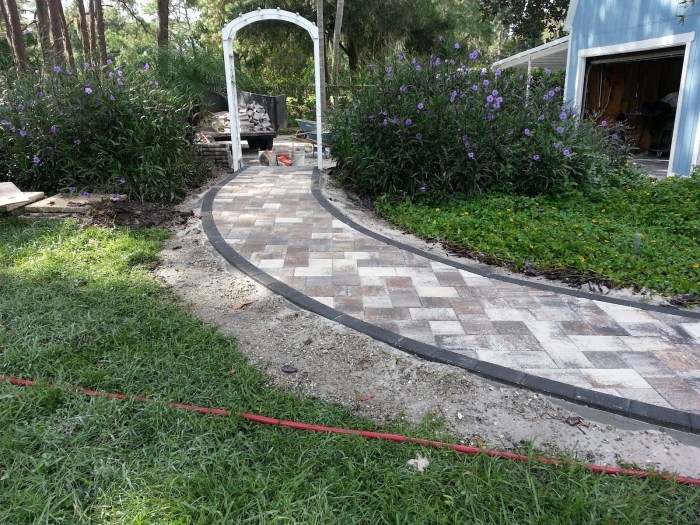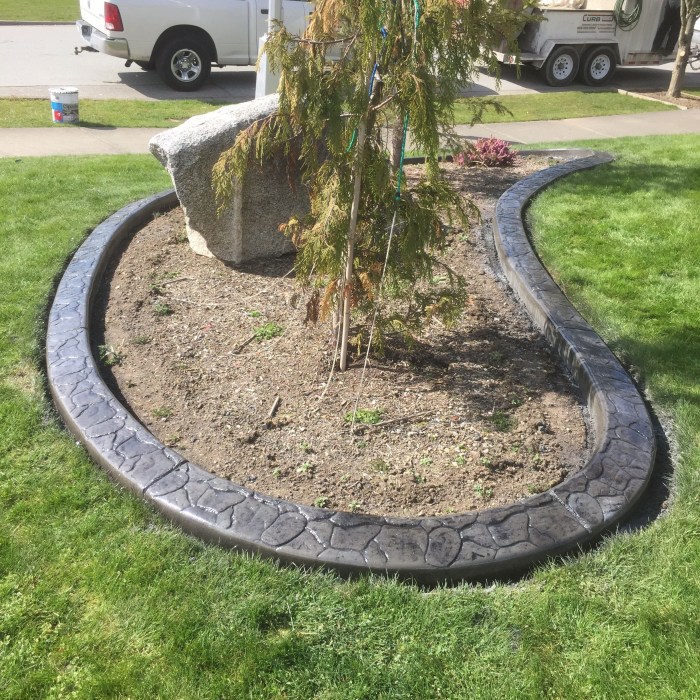DIY concrete edging sets the stage for a transformative landscaping journey, offering a blend of practicality and aesthetic appeal. Whether you’re a seasoned gardener or a novice landscaper, concrete edging presents an opportunity to define spaces, enhance curb appeal, and elevate the overall design of your outdoor oasis. This comprehensive guide delves into the world of DIY concrete edging, providing insights into its history, types, installation, and maintenance, empowering you to create stunning and durable edging solutions.
Concrete edging has evolved from a simple utilitarian element to a versatile design feature. Its enduring nature, coupled with its adaptability to various landscaping styles, makes it an ideal choice for creating clean lines, defining pathways, and outlining flower beds. From the classic straight edges to intricate curves and patterns, concrete edging allows for a wide range of creative expressions, transforming your outdoor space into a personalized haven.
Introduction to DIY Concrete Edging

Concrete edging is a versatile and durable landscaping element that can add a touch of elegance and definition to your outdoor spaces. It offers a range of benefits, including enhanced curb appeal, improved functionality, and long-lasting beauty.
Benefits of Concrete Edging
Concrete edging provides several advantages that make it a popular choice for landscaping projects.
- Enhanced Curb Appeal: Concrete edging creates clean lines and defined boundaries, enhancing the overall aesthetic appeal of your landscaping. It can transform a simple yard into a more polished and inviting space.
- Improved Functionality: Concrete edging serves as a barrier to prevent grass and plants from encroaching into walkways, flower beds, and other areas. It helps maintain a neat and organized appearance, reducing the need for constant trimming and weeding.
- Durability and Longevity: Concrete is a robust material that can withstand harsh weather conditions, foot traffic, and lawn care equipment. Concrete edging provides long-lasting durability, minimizing the need for frequent repairs or replacements.
- Versatility: Concrete edging comes in various shapes, sizes, and colors, offering flexibility in design and customization. You can create straight lines, curves, and intricate patterns to match your landscaping style.
- Cost-Effectiveness: DIY concrete edging can be a cost-effective solution compared to hiring professional landscapers. With readily available materials and instructions, you can create beautiful edging without breaking the bank.
History of Concrete Edging
The use of concrete for edging dates back centuries, with evidence of its application in ancient Roman and Greek architecture. Early forms of concrete edging were often simple and functional, serving primarily as boundaries for walkways and gardens.
Over time, concrete edging has evolved with advancements in materials and techniques. Today, it encompasses a wide range of styles, from classic straight lines to intricate curves and decorative patterns. The use of concrete edging has expanded beyond its traditional role, becoming a popular design element in modern landscaping.
DIY concrete edging can be a rewarding project, adding a touch of elegance and structure to your garden. While you’re working on your project, remember that taking care of your mental health is important. If you’re struggling with depression, consider reaching out to a medical professional and exploring resources like information on antidepressant drugs. Once you’ve taken care of your mental wellbeing, you can return to your DIY project with renewed energy and focus, ensuring your concrete edging turns out just as you envisioned.
Applications of Concrete Edging
Concrete edging finds applications in various landscaping projects, enhancing both functionality and aesthetics.
- Defining Walkways and Paths: Concrete edging creates clean lines and boundaries for walkways, guiding foot traffic and preventing erosion.
- Enhancing Flower Beds and Gardens: Concrete edging defines flower beds and gardens, creating a polished and organized look while preventing plants from encroaching into surrounding areas.
- Creating Patio and Deck Borders: Concrete edging provides a defined border for patios and decks, enhancing their visual appeal and separating them from surrounding landscaping.
- Separating Lawn Areas: Concrete edging can be used to separate different lawn areas, creating distinct zones for different purposes, such as play areas or vegetable gardens.
Types of Concrete Edging

Concrete edging is a popular and versatile landscaping feature that can enhance the curb appeal of any property. It provides a clean, defined border for gardens, walkways, and patios, while also adding durability and longevity. There are several types of concrete edging available, each with its own advantages and disadvantages.
Precast Concrete Edging
Precast concrete edging is manufactured in a factory and comes in various shapes, sizes, and styles. This type of edging is easy to install and requires minimal effort.
Precast concrete edging offers several benefits:
- Easy installation: Precast concrete edging is typically lightweight and easy to handle, making installation a breeze. It can be installed using simple tools and requires minimal effort.
- Durability: Concrete is a durable material that can withstand harsh weather conditions and foot traffic. Precast edging is built to last and will not crack or fade easily.
- Variety of styles: Precast concrete edging comes in a wide range of styles, from traditional to modern, allowing you to choose the perfect look for your landscaping.
However, precast edging also has some drawbacks:
- Limited customization: Precast concrete edging is limited to the styles and sizes available from the manufacturer. This may not be suitable for projects requiring specific shapes or sizes.
- Higher cost: Precast concrete edging can be more expensive than other types of edging, especially for large projects.
Precast concrete edging is suitable for various landscaping applications, including:
- Defining flower beds: Precast concrete edging can create a clean and defined border for flower beds, preventing plants from spreading into surrounding areas.
- Creating walkways: Precast edging can be used to create pathways through gardens or around patios, providing a durable and attractive surface for walking.
- Enhancing patios: Precast concrete edging can be used to define the perimeter of patios, adding a touch of elegance and sophistication to the space.
Poured Concrete Edging
Poured concrete edging is created on-site by pouring concrete into a form. This allows for greater customization in terms of shape, size, and design.
Poured concrete edging offers several advantages:
- Customization: Poured concrete edging allows you to create unique designs and shapes that perfectly complement your landscaping.
- Durability: Poured concrete edging is extremely durable and can withstand heavy foot traffic and harsh weather conditions.
- Cost-effective: Poured concrete edging can be a cost-effective option for large projects, especially when compared to precast concrete edging.
However, poured concrete edging also has some disadvantages:
- Time-consuming installation: Poured concrete edging requires more time to install than precast edging, as it involves mixing concrete and pouring it into forms.
- Requires skilled labor: Pouring concrete requires experience and skill to ensure a smooth and even finish.
Poured concrete edging is well-suited for various landscaping applications, including:
- Creating curved borders: Poured concrete edging is ideal for creating curved borders for gardens, walkways, and patios.
- Building retaining walls: Poured concrete can be used to create retaining walls, which can be used to support slopes or create tiered gardens.
- Adding unique designs: Poured concrete edging allows you to incorporate unique designs, such as patterns or textures, into your landscaping.
Stamped Concrete Edging, Diy concrete edging
Stamped concrete edging is a type of poured concrete edging that is stamped with a pattern to create a decorative finish. This technique allows you to mimic the look of other materials, such as brick, stone, or wood.
Stamped concrete edging offers several benefits:
- Aesthetic appeal: Stamped concrete edging can create a beautiful and decorative finish that enhances the curb appeal of any property.
- Durability: Stamped concrete edging is as durable as poured concrete edging and can withstand harsh weather conditions and foot traffic.
- Versatility: Stamped concrete edging can be used to create a wide variety of designs and patterns, allowing you to match the style of your home or landscaping.
However, stamped concrete edging also has some disadvantages:
- Higher cost: Stamped concrete edging is typically more expensive than poured concrete edging due to the additional labor and materials required.
- Requires skilled labor: Stamping concrete requires experience and skill to ensure a consistent and aesthetically pleasing finish.
Stamped concrete edging is suitable for various landscaping applications, including:
- Creating decorative borders: Stamped concrete edging can be used to create decorative borders for gardens, walkways, and patios.
- Mimicking other materials: Stamped concrete edging can be used to mimic the look of other materials, such as brick, stone, or wood, creating a unique and stylish finish.
- Adding a touch of elegance: Stamped concrete edging can add a touch of elegance and sophistication to any landscaping project.
Materials and Tools
Before embarking on your DIY concrete edging project, you’ll need to gather the necessary materials and tools. This will vary slightly depending on the type of edging you choose, but there are some essential items common to most projects.
Materials
The materials you’ll need for your DIY concrete edging project depend on the type of edging you’re creating. Here’s a general list of materials commonly used for most types:
- Concrete mix: The foundation of your edging. Choose a pre-mixed bag or create your own mix using Portland cement, sand, and gravel.
- Water: Used to activate the concrete mix, ensuring proper hydration and workability.
- Forms: These define the shape and size of your edging. They can be made from wood, metal, or plastic, and can be purchased or DIYed.
- Reinforcement: Optional, but highly recommended for increased strength and durability. Use rebar, wire mesh, or fiber reinforcement.
- Sealing agent: A protective layer that helps prevent water damage and cracking. Apply after the concrete has cured.
- Optional: Pigment for color, decorative stones, or other embellishments to enhance the visual appeal of your edging.
Tools
Having the right tools on hand will make your DIY concrete edging project much smoother. Here’s a breakdown of essential tools:
- Mixing tools:
- Wheelbarrow: Provides a portable and stable platform for mixing the concrete.
- Shovel: Used to mix the concrete and transfer it to the forms.
- Hoe: A handy tool for blending the concrete mix and removing air bubbles.
- Form tools:
- Tape measure: Accurate measurement is crucial for creating consistent edging.
- Level: Ensures the edging is straight and level, preventing unevenness.
- Hammer: Used to secure the forms and make adjustments.
- Staple gun: Optional for securing forms, especially for wood forms.
- Finishing tools:
- Trowel: A versatile tool for smoothing the concrete surface and creating a finished look.
- Edger: Used to create clean, defined edges along the concrete.
- Float: A large, flat tool used to level and smooth the concrete surface.
- Joint tool: Used to create decorative joints or grooves in the concrete.
- Hand tamper: Used to compact the concrete, removing air pockets and creating a denser surface.
- Safety equipment:
- Safety glasses: Protect your eyes from flying debris during mixing and finishing.
- Work gloves: Protect your hands from rough surfaces and concrete dust.
- Dust mask: Avoid inhaling concrete dust, which can be harmful to your respiratory system.
- Boots: Provide stability and protection from spills and splashes.
Embarking on a DIY concrete edging project opens a world of possibilities for enhancing your landscaping. By understanding the various types of edging, mastering the installation process, and implementing proper maintenance techniques, you can create a durable and visually appealing landscape that reflects your unique style. Whether you’re defining walkways, outlining flower beds, or adding a touch of elegance to your patio, concrete edging offers a versatile and enduring solution to elevate your outdoor spaces.
